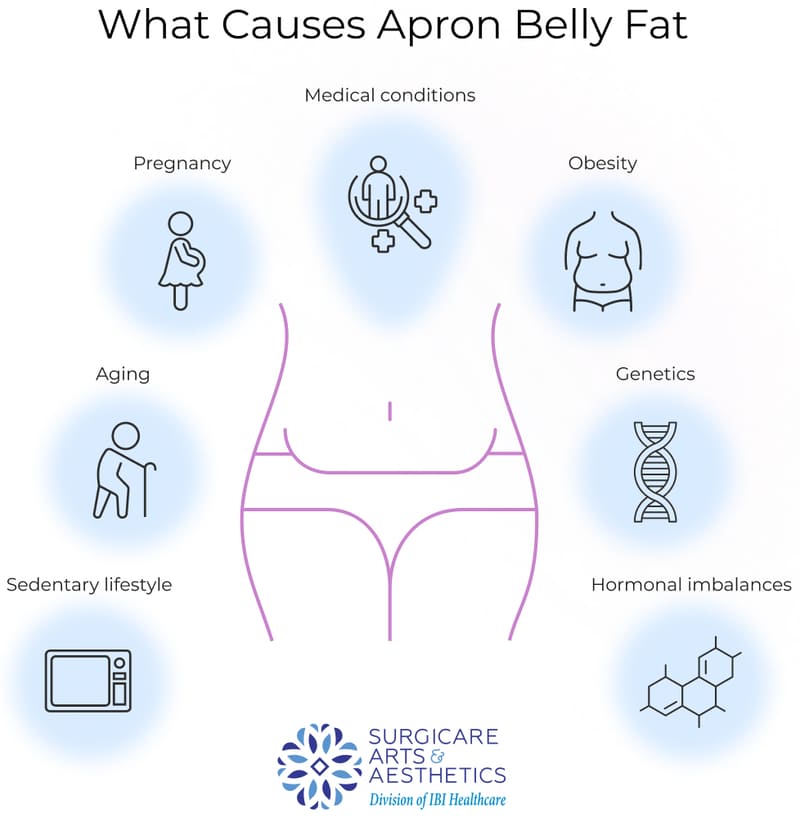What Causes An Apron Belly?
Apron belly is a common term that is used to describe a condition medically known as pannus stomach. It happens when an individual has a large accumulation of fat and skin that hangs down from their abdomen. It was given the name “apron belly” because this extra tissue and fat is often large enough to hang down and look like a cook’s apron. It tends to be more common in females than in their male counterparts; however, the condition can affect both genders.
Today we are going to take a look at what can cause an apron belly to develop, the symptoms it can create, and what treatment options are available for addressing this condition.
What Can Cause Apron Belly Fat?
When a large amount of fat gathers in the lower area of the abdomen, it can hang down, drape, or fold over itself. Because women generally have a higher fat content than men, they tend to be the ones to have issues with this condition; however, men can also develop an apron belly.

Some of the factors that can promote the development of an apron belly include:
- Carrying Too Much Extra Weight
- Individuals who suffer from overweight or obesity tend to be more likely to end up with an apron belly. It can depend on how much excess fat they are carrying and how it is distributed throughout their body.
- Changes Resulting From Pregnancy
- Women who have experienced a pregnancy and delivered a baby can have issues with an apron belly because of weight gain and the fact that their abdominal muscles may become significantly stretched and weak. If they are carrying excess weight from fat in their stomach, these muscles may no longer be able to support it, and it may sag and hang down.
- Getting Older
- When we get older, our metabolism gets slower, and most people tend to gain weight. Many people begin to store these extra pounds on their belly, and depending on the degree of weight gain, an apron belly can develop.
- DNA/Genetics
- Certain individuals are more apt to develop this extra fat fold because of their genetic predisposition.
- An Imbalance Of Hormones
- Hormones control a wide variety of functions in our body, and when they get out of whack, they can cause some serious issues. During menopause, many women experience hormone imbalances and begin to gain weight. If this weight accumulates in their abdominal area, it can trigger the formation of an apron belly.
- Non-Active Lifestyle
- Individuals who do not stay active or get enough exercise can gain weight. This often happens in the midsection and leads to love handles, which, if not kept in check, can develop into an apron belly.
- Health Conditions
- Individuals with insulin resistance or certain medical conditions, such as Cushing’s syndrome, can have issues with weight control and excess fat storage. If this fat is stored in their abdomen, they may end up with the folds and draping tissue that cause apron belly.
What Are The Symptoms Of Apron Belly?
The most obvious and telltale symptom of apron belly is a flap of hanging tissue that extends off the lower portion of the abdomen. Depending on the density of the fat within this fold, it may feel squishy and mashable, or it can feel hard and more firm. Some of the other signs that indicate an apron belly can include:
- Irritated Skin: The buildup of fat and extra skin can create rashes or cause irritation as the skin rubs against itself.
- Issues With Getting Around: The hanging flap of fat and skin can make mobility difficult for some who suffer from pannus stomach. The degree of difficulty is related to how large and heavy the overhanging tissue is and how far downward it extends.
- Discomfort: This condition often exerts pressure from the outside, affecting the organs and tissues housed inside the abdominal wall, and can cause pain and significant discomfort.
- Bad Posture: Sometimes people who suffer from pannus stomach do not stand up straight because their stomach fat is so heavy that it stretches their muscles, pulls on their spine, and causes them to lean forward.
How Is Pannus Stomach Treated?
There are different ways to treat this condition, and the treatment chosen will be commensurate with the degree of severity while also taking the underlying cause into consideration. Some of the treatment options that may be used include:
Dietary Adjustments
The first alterations that are usually put into place are significant changes to the types of foods being consumed. It is important that these individuals gain a good understanding of how important nutrition is and how to tell the difference between a healthy, low-calorie food choice and an unhealthy one. Focusing on eating foods that offer the highest concentration of nutrition and have fewer calories can help with maintaining a healthy weight.
Physical Activity
Burning calories and increasing muscle mass can help reduce the amount of fat in the body and will cause the metabolism to speed up and elevate the rate at which calories are burned.
Bariatric Surgery
In certain instances, surgical intervention such as a gastric sleeve or gastric bypass may be necessary to assist with weight loss. This would most likely be followed by another surgical procedure to eliminate the excess loose, saggy skin and surplus fat.
Plastic/Cosmetic Surgery
After an individual loses a great deal of weight, they are often left with extra fat and loose skin that not only looks unattractive but can also cause medical and emotional issues. A surgical procedure such as a tummy tuck (abdominoplasty) can eliminate this extra fat and skin from the stomach. Additionally, this surgery can correct ripped or overly stretched muscles, which can help strengthen their core and improve posture.
What Is The Best Way To Prevent Apron Belly?
Most cases of apron belly develop due to choices the individual has made. These choices may have started within their control and, over time, developed into a situation they no longer had power over for one reason or another.
You know the old saying “an ounce of prevention is worth a ton of cure” is true in this case as well. The best way to keep from ending up with an apron belly is to eat a healthy diet that is calorie-controlled and to engage in plenty of physical exercise. Making continuous lifestyle choices that promote maintaining a healthy weight will keep your body in good shape and prevent the development of an apron belly.
Where Can I Go To Get Rid Of My Apron Belly?
If you are concerned or embarrassed about your apron belly and would like to explore options for reducing or eliminating it, contact IBI Plastic Surgery & Med Spa.
Dr. Angelina Posteov has extensive experience performing tummy tucks (abdominoplasty) to remove excess fat and loose skin from the abdominal area, resulting in a smoother, more toned appearance. She has also performed cosmetic procedures on weight loss patients to tighten, tone, provide contouring enhancements, and improve their mobility after they have lost a significant amount of weight.
IBI Plastic Surgery & Med Spa offers surgical and non-surgical procedures for tightening, toning, and transforming your areas of concern. Set up your consultation today and learn how we can help turn your aesthetic dreams into reality.







